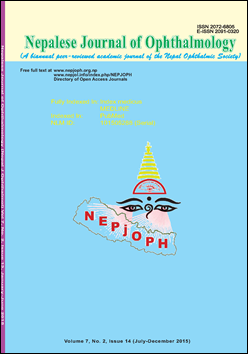The indications for and the diagnostic yield of imaging in neuro-ophthalmic and orbital disorders
DOI:
https://doi.org/10.3126/nepjoph.v7i2.14966Keywords:
Diagnostic yield, neuro-ophthalmology, neuro-imagingAbstract
Correction: On 7th June, the first author's name was changed FROM Eli Ranjitkar Pradan TO Eli Pradhan
Introduction: Neuro-imaging is an important method of investigation in neuro- ophthalmic and orbital conditions. These investigations are expensive and time consuming. This study describes the diagnostic yield of neuroimaging in patients referred from neuro-ophthalmic services.
Objective: To evaluate the diagnostic yield of neuroimaging in patients with neuro-ophthalmic and orbital disorders.
Materials and methods: Retrospective review of records of 188 patients referred to radiology department for imaging by the neuro-ophthalmic servicesat University Hospital Coventry.
Main outcome measures: Imaging findings were defined to be significant, if it led to changes in patient management, and as relevant, if the abnormal imaging finding related to the patient’s neuro-ophthalmic complaint, examination finding or condition. The imaging findings were categorized into five groups based on significance and relevance as (a) significant and relevant, (b) significant and not relevant, (c) relevant and not significant, (d) not significant and not relevant, or (e) normal. The percentage of tests with a significant and relevant finding was defined as the diagnostic yield. The yield of the imaging test ordered was also analyzed based on neuro-ophthalmic examination findings and indication for imaging.
Results: One hundred and eighty eight neuro-imaging studies were analyzed. The majority of this referral was made for evaluation of the orbit (30%) and the anterior visual pathway (22%), followed by motility disorder (16%) and cerebro vascular accidents (11%). Hemifacial spasm, nystagmus and headache were less common indications for imaging referral. Sixty-one (32.4%) had significant and relevant findings to the patient’s neuro- ophthalmic condition. In the majority (33/61, 54%), imaging was done to evaluate the orbit.
Conclusion: Among the imaging referral from neuro-ophthalmic practice, request for evaluation of the orbit provides a higher diagnostic yield.
Downloads
Downloads
Published
How to Cite
Issue
Section
License
This license enables reusers to copy and distribute the material in any medium or format in unadapted form only, for noncommercial purposes only, and only so long as attribution is given to the creator.




